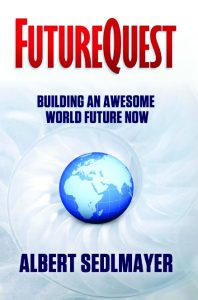 FutureQuest is a book about the future – a new sustainable world future. A future that everyone can take part in and help to build. We all share this planet and we can all do something towards improving our current situation. No matter how small you feel your part may be, its still important in creating the future as we want it to be – free from war, free from poverty, free from violence, suppression and abuse. It is only with YOUR help that this can be done, no part is too small, it all counts.
FutureQuest is a book about the future – a new sustainable world future. A future that everyone can take part in and help to build. We all share this planet and we can all do something towards improving our current situation. No matter how small you feel your part may be, its still important in creating the future as we want it to be – free from war, free from poverty, free from violence, suppression and abuse. It is only with YOUR help that this can be done, no part is too small, it all counts.
FutureQuest engages thinking people everywhere who want to build a sustainable, peaceful future but are overwhelmed by the immensity of the task. Since everything we individually and collectively do today has an effect on the quality of our future, and presents a generic approach free of political, religious and ideological influences.
FutureQuest is split into eight chapters, and containing sixty-one sub-chapters.
Chapter One provides orientation on scope and methodology to build confidence that a great world future is indeed achievable. My opening paragraphs paint an image of the future we could have, and set that as our goal.
Chapter Two examines Man – the individual. We look at our motivation and influences and how we can optimise our own actions to facilitate our goal. Essentially, all groups and organisations comprise individuals, some of whom will read this book and become inspired and empowered to do their part in building a better future, in turn motivating their respective organisations.
Chapter Three deals with group structures and how mankind functions within its diverse groups. In particular we examine ways to mitigate friction between groups, including the use of information-age technology.
Chapter Four takes a critical look at government systems and their effect on our future. We focus on those government structures and attitudes detrimental to survival, and how we can adjust them.
Chapter Five simulates a typical process of starting and running a business, particularly along a path of maximising profits. We consider how the power of shareholders and decision-makers influence our future. Problem areas of globalisation are examined and prototype solutions proposed.
Chapter Six discusses our key institutions and organisations, and how human fears tend to veer them into destructive directions. We propose ways of keeping them on course.
Chaper Seven looks at trans-governmental matters, including the United Nations Organisation. We examine the ‘Tragedy of the Commons’ script, sustainability and the real possibility of mankind’s extinction. We then see how we can change the script.
Chapter Eight looks at how all these civilisation structures and systems work together in shaping humanity. Here we take stock of where we are now and where we want to go. The last chapter summarises the steps we must take to build our awesome future.
A thoroughly-researched bibliography of 323 ISO 690 Numerical Reference citations concludes the book. My FutureQuest website replicates the bibliography with active hyperlinks to most citation sources, to encourage reader participation.
FutureQuest is a book about YOUR future. Be in it!
To be released in Paperback POD and eBook.
Release date: December 2012